On Sunday, August 18, 2019, at 2:30 p.m. Pacific Daylight Time, the U.S. Department of Defense conducted a flight test of a conventionally-configured ground-launched cruise missile at San Nicolas Island, California.

On August 18, 2019, at 2:30 p.m. Pacific Daylight Time, the Defense Department conducted a flight test of a conventionally configured ground-launched cruise missile at San Nicolas Island, Calif. (Picture source U.S. DoD)
The test missile exited its ground mobile launcher and accurately impacted its target after more than 500 kilometers of flight. Data collected and lessons learned from this test will inform the Department of Defense's development of future intermediate-range capabilities.
The United States will fully develop ground-launched conventional missiles after withdrawing from the INF (Intermediate-Range Nuclear Forces) Treaty earlier this month, said US Secretary of Defense Mark Esper a few days ago. The Pentagon could test an intermediate-range ballistic missile in November of this year, he added.
In the year 80s, Russia and the U.S. have signed the INF with the goal to reduce ground-launched ballistic and cruise missiles with ranges of between 500 and 5,500 kilometers, their launchers and associated support structures and support equipment.
According to Missile Defense Agency (MDA), U.S. has appropriated over $200 billion for the agency’s programs between fiscal years 1985 and 2019. That total does not include spending by the military services on programs such as the Patriot system or the many additional tens of billions of dollars spent since work on anti-missile systems first began in the 1950s.
For nearly two decades, U.S. ballistic missile defense (BMD) policy has sought to protect the homeland against limited long-range missile strikes from states such as Iran and North Korea, but not major nuclear powers like Russia and China, because that mission would pose significant technical, financial, and geopolitical challenges.














